Health Care Case Study: Application of Cognitive Behavioural Therapy
VerifiedAdded on 2023/06/15
|14
|3968
|262
Case Study
AI Summary
This assignment delves into the application of cognitive behavioral therapy (CBT) within a health care context, utilizing a case study of Andrew, a patient with a severe spinal injury resulting from an accident. The study highlights the psychological challenges faced by individuals with accident-acquired disabilities, emphasizing the importance of addressing both physical and mental well-being. It identifies crucial interpersonal skills for care providers, such as effective verbal and nonverbal communication, empathy, and respect for the patient's perspectives. The assignment connects CBT principles—cognition, emotion, and behavior—to the case study, proposing solutions like identifying and challenging distorted cognitions, documenting emotional changes, and employing rational emotive behavioral therapy and the cognitive triad to foster positive interpretations and improve the patient's overall quality of life. The goal is to empower Andrew, facilitate his active involvement in his care plan, and promote a sense of control over his progress, ultimately leading to a more optimistic outlook on his future. Desklib provides comprehensive study tools and resources for students.
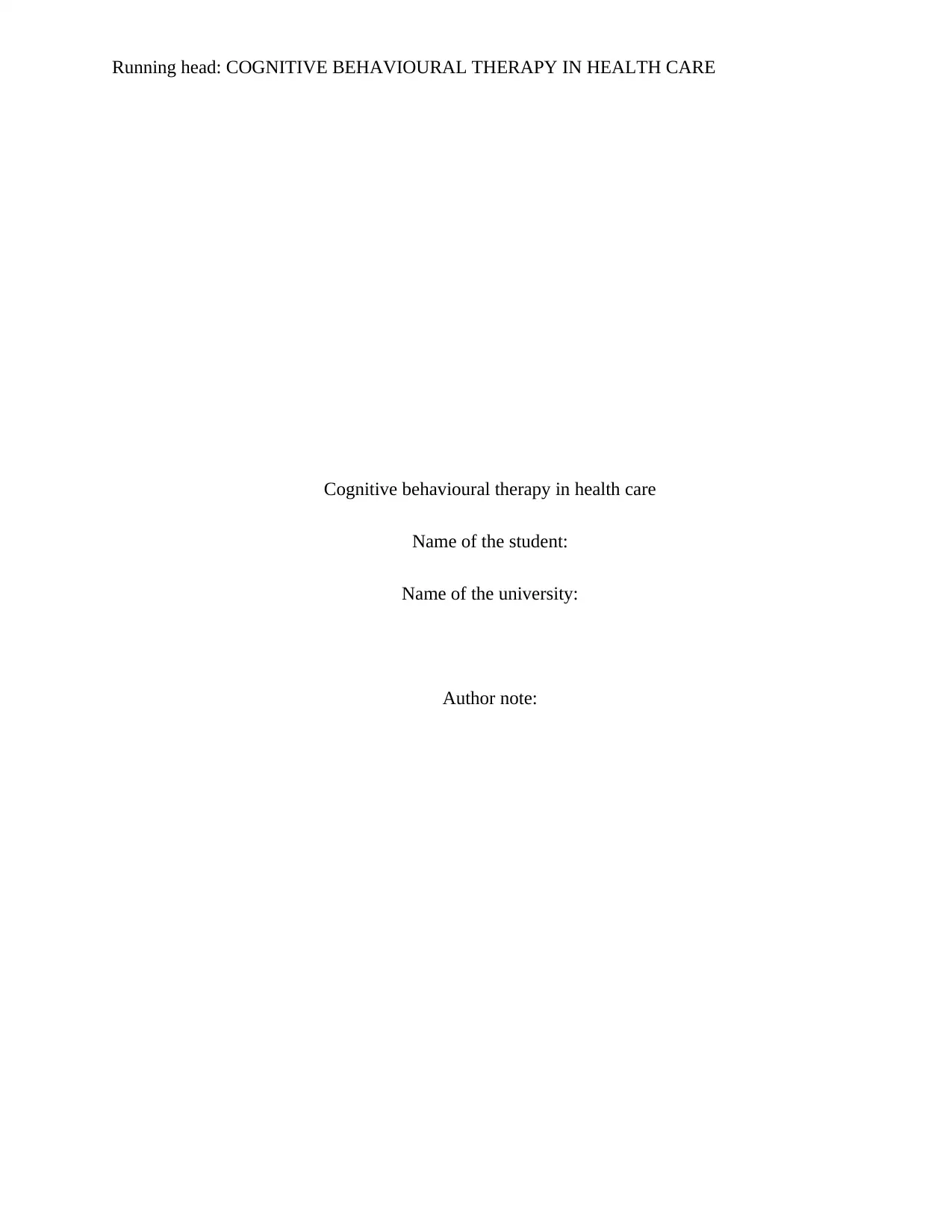
Running head: COGNITIVE BEHAVIOURAL THERAPY IN HEALTH CARE
Cognitive behavioural therapy in health care
Name of the student:
Name of the university:
Author note:
Cognitive behavioural therapy in health care
Name of the student:
Name of the university:
Author note:
Paraphrase This Document
Need a fresh take? Get an instant paraphrase of this document with our AI Paraphraser
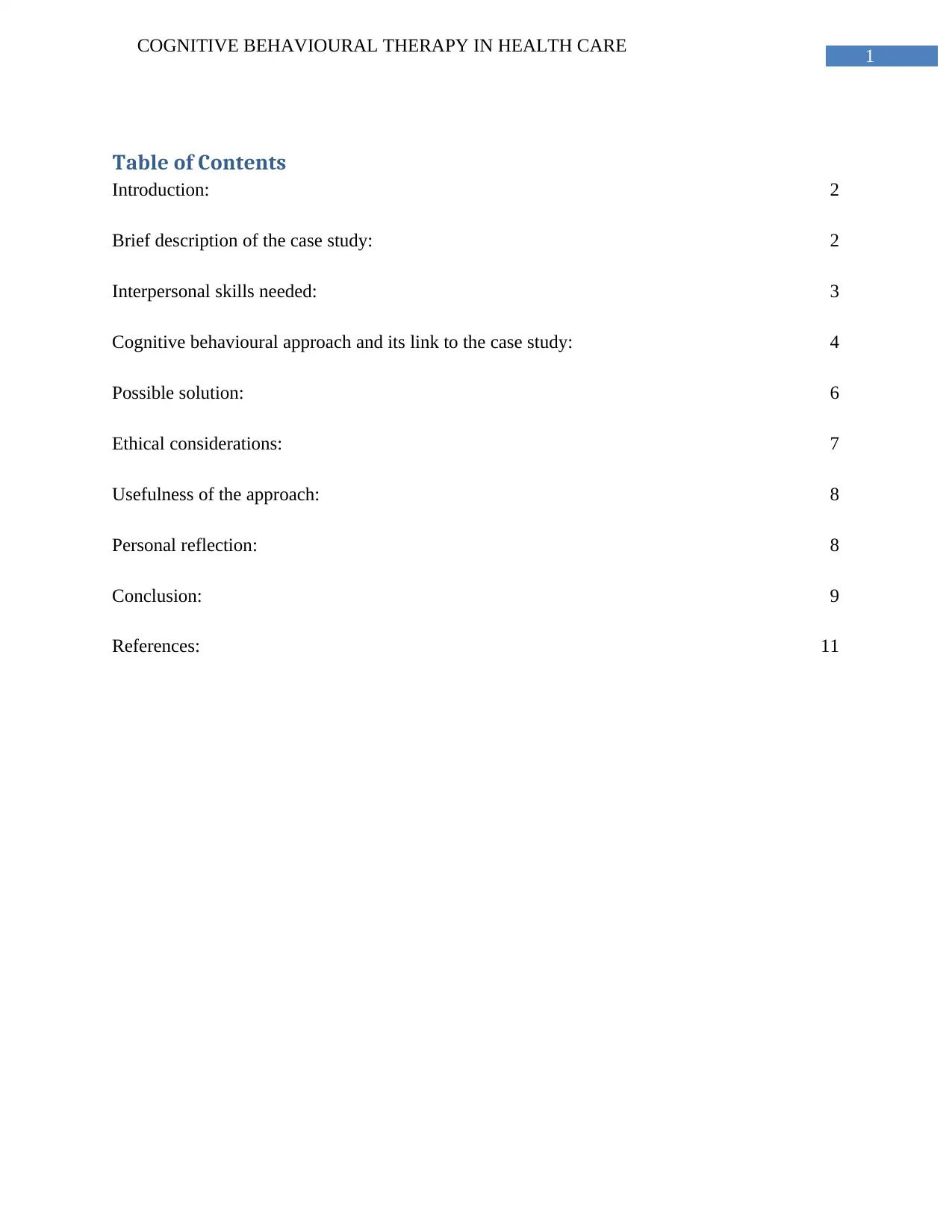
1
COGNITIVE BEHAVIOURAL THERAPY IN HEALTH CARE
Table of Contents
Introduction: 2
Brief description of the case study: 2
Interpersonal skills needed: 3
Cognitive behavioural approach and its link to the case study: 4
Possible solution: 6
Ethical considerations: 7
Usefulness of the approach: 8
Personal reflection: 8
Conclusion: 9
References: 11
COGNITIVE BEHAVIOURAL THERAPY IN HEALTH CARE
Table of Contents
Introduction: 2
Brief description of the case study: 2
Interpersonal skills needed: 3
Cognitive behavioural approach and its link to the case study: 4
Possible solution: 6
Ethical considerations: 7
Usefulness of the approach: 8
Personal reflection: 8
Conclusion: 9
References: 11
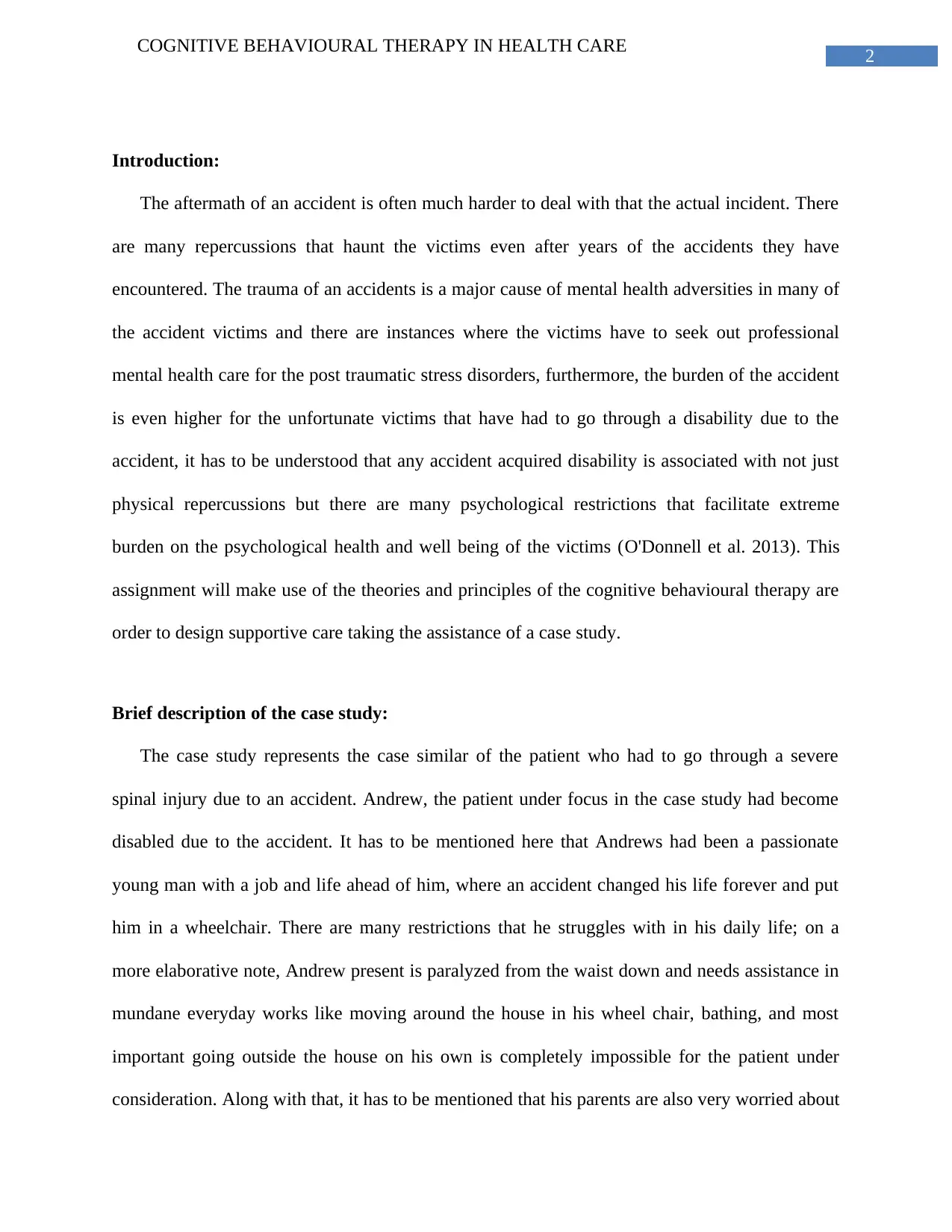
2
COGNITIVE BEHAVIOURAL THERAPY IN HEALTH CARE
Introduction:
The aftermath of an accident is often much harder to deal with that the actual incident. There
are many repercussions that haunt the victims even after years of the accidents they have
encountered. The trauma of an accidents is a major cause of mental health adversities in many of
the accident victims and there are instances where the victims have to seek out professional
mental health care for the post traumatic stress disorders, furthermore, the burden of the accident
is even higher for the unfortunate victims that have had to go through a disability due to the
accident, it has to be understood that any accident acquired disability is associated with not just
physical repercussions but there are many psychological restrictions that facilitate extreme
burden on the psychological health and well being of the victims (O'Donnell et al. 2013). This
assignment will make use of the theories and principles of the cognitive behavioural therapy are
order to design supportive care taking the assistance of a case study.
Brief description of the case study:
The case study represents the case similar of the patient who had to go through a severe
spinal injury due to an accident. Andrew, the patient under focus in the case study had become
disabled due to the accident. It has to be mentioned here that Andrews had been a passionate
young man with a job and life ahead of him, where an accident changed his life forever and put
him in a wheelchair. There are many restrictions that he struggles with in his daily life; on a
more elaborative note, Andrew present is paralyzed from the waist down and needs assistance in
mundane everyday works like moving around the house in his wheel chair, bathing, and most
important going outside the house on his own is completely impossible for the patient under
consideration. Along with that, it has to be mentioned that his parents are also very worried about
COGNITIVE BEHAVIOURAL THERAPY IN HEALTH CARE
Introduction:
The aftermath of an accident is often much harder to deal with that the actual incident. There
are many repercussions that haunt the victims even after years of the accidents they have
encountered. The trauma of an accidents is a major cause of mental health adversities in many of
the accident victims and there are instances where the victims have to seek out professional
mental health care for the post traumatic stress disorders, furthermore, the burden of the accident
is even higher for the unfortunate victims that have had to go through a disability due to the
accident, it has to be understood that any accident acquired disability is associated with not just
physical repercussions but there are many psychological restrictions that facilitate extreme
burden on the psychological health and well being of the victims (O'Donnell et al. 2013). This
assignment will make use of the theories and principles of the cognitive behavioural therapy are
order to design supportive care taking the assistance of a case study.
Brief description of the case study:
The case study represents the case similar of the patient who had to go through a severe
spinal injury due to an accident. Andrew, the patient under focus in the case study had become
disabled due to the accident. It has to be mentioned here that Andrews had been a passionate
young man with a job and life ahead of him, where an accident changed his life forever and put
him in a wheelchair. There are many restrictions that he struggles with in his daily life; on a
more elaborative note, Andrew present is paralyzed from the waist down and needs assistance in
mundane everyday works like moving around the house in his wheel chair, bathing, and most
important going outside the house on his own is completely impossible for the patient under
consideration. Along with that, it has to be mentioned that his parents are also very worried about
⊘ This is a preview!⊘
Do you want full access?
Subscribe today to unlock all pages.

Trusted by 1+ million students worldwide
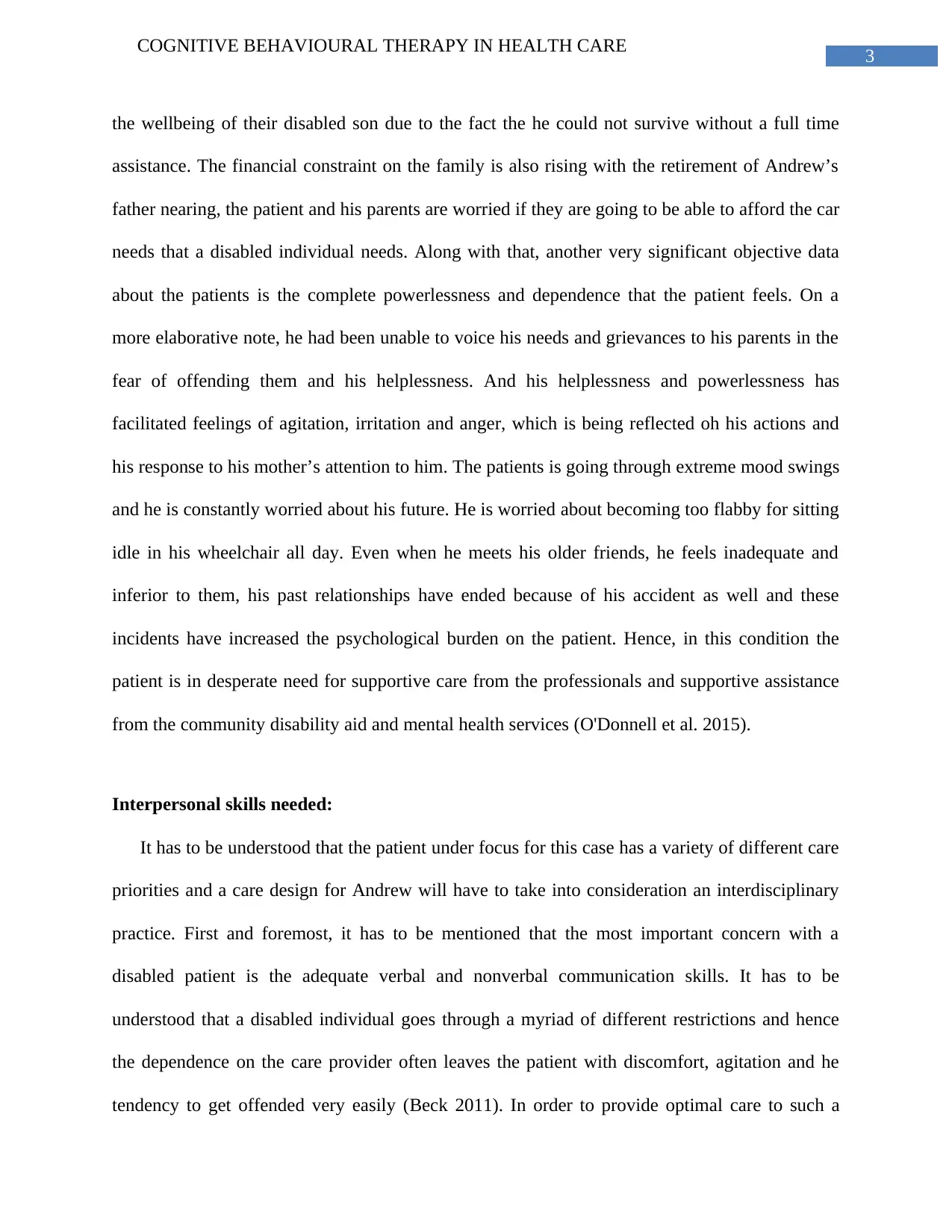
3
COGNITIVE BEHAVIOURAL THERAPY IN HEALTH CARE
the wellbeing of their disabled son due to the fact the he could not survive without a full time
assistance. The financial constraint on the family is also rising with the retirement of Andrew’s
father nearing, the patient and his parents are worried if they are going to be able to afford the car
needs that a disabled individual needs. Along with that, another very significant objective data
about the patients is the complete powerlessness and dependence that the patient feels. On a
more elaborative note, he had been unable to voice his needs and grievances to his parents in the
fear of offending them and his helplessness. And his helplessness and powerlessness has
facilitated feelings of agitation, irritation and anger, which is being reflected oh his actions and
his response to his mother’s attention to him. The patients is going through extreme mood swings
and he is constantly worried about his future. He is worried about becoming too flabby for sitting
idle in his wheelchair all day. Even when he meets his older friends, he feels inadequate and
inferior to them, his past relationships have ended because of his accident as well and these
incidents have increased the psychological burden on the patient. Hence, in this condition the
patient is in desperate need for supportive care from the professionals and supportive assistance
from the community disability aid and mental health services (O'Donnell et al. 2015).
Interpersonal skills needed:
It has to be understood that the patient under focus for this case has a variety of different care
priorities and a care design for Andrew will have to take into consideration an interdisciplinary
practice. First and foremost, it has to be mentioned that the most important concern with a
disabled patient is the adequate verbal and nonverbal communication skills. It has to be
understood that a disabled individual goes through a myriad of different restrictions and hence
the dependence on the care provider often leaves the patient with discomfort, agitation and he
tendency to get offended very easily (Beck 2011). In order to provide optimal care to such a
COGNITIVE BEHAVIOURAL THERAPY IN HEALTH CARE
the wellbeing of their disabled son due to the fact the he could not survive without a full time
assistance. The financial constraint on the family is also rising with the retirement of Andrew’s
father nearing, the patient and his parents are worried if they are going to be able to afford the car
needs that a disabled individual needs. Along with that, another very significant objective data
about the patients is the complete powerlessness and dependence that the patient feels. On a
more elaborative note, he had been unable to voice his needs and grievances to his parents in the
fear of offending them and his helplessness. And his helplessness and powerlessness has
facilitated feelings of agitation, irritation and anger, which is being reflected oh his actions and
his response to his mother’s attention to him. The patients is going through extreme mood swings
and he is constantly worried about his future. He is worried about becoming too flabby for sitting
idle in his wheelchair all day. Even when he meets his older friends, he feels inadequate and
inferior to them, his past relationships have ended because of his accident as well and these
incidents have increased the psychological burden on the patient. Hence, in this condition the
patient is in desperate need for supportive care from the professionals and supportive assistance
from the community disability aid and mental health services (O'Donnell et al. 2015).
Interpersonal skills needed:
It has to be understood that the patient under focus for this case has a variety of different care
priorities and a care design for Andrew will have to take into consideration an interdisciplinary
practice. First and foremost, it has to be mentioned that the most important concern with a
disabled patient is the adequate verbal and nonverbal communication skills. It has to be
understood that a disabled individual goes through a myriad of different restrictions and hence
the dependence on the care provider often leaves the patient with discomfort, agitation and he
tendency to get offended very easily (Beck 2011). In order to provide optimal care to such a
Paraphrase This Document
Need a fresh take? Get an instant paraphrase of this document with our AI Paraphraser
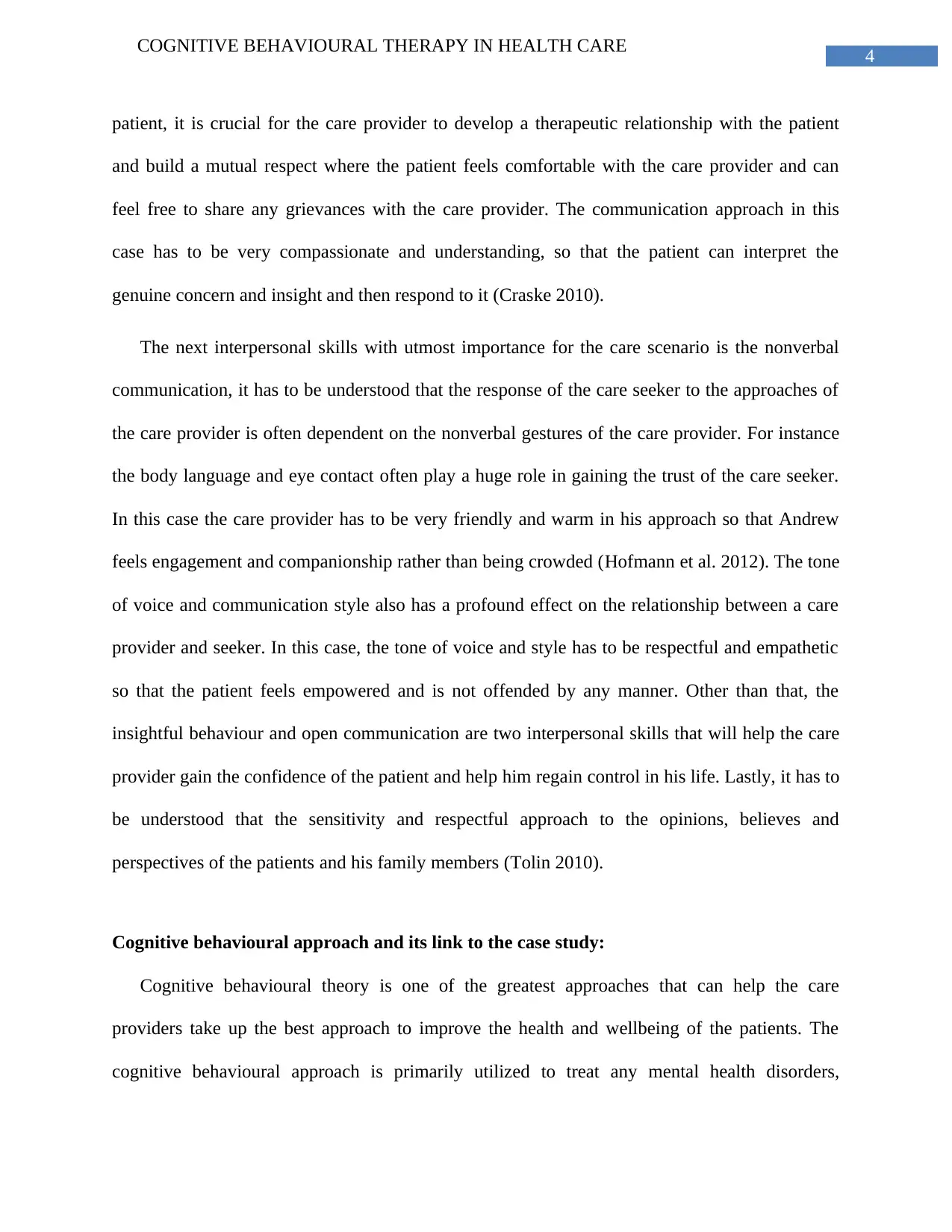
4
COGNITIVE BEHAVIOURAL THERAPY IN HEALTH CARE
patient, it is crucial for the care provider to develop a therapeutic relationship with the patient
and build a mutual respect where the patient feels comfortable with the care provider and can
feel free to share any grievances with the care provider. The communication approach in this
case has to be very compassionate and understanding, so that the patient can interpret the
genuine concern and insight and then respond to it (Craske 2010).
The next interpersonal skills with utmost importance for the care scenario is the nonverbal
communication, it has to be understood that the response of the care seeker to the approaches of
the care provider is often dependent on the nonverbal gestures of the care provider. For instance
the body language and eye contact often play a huge role in gaining the trust of the care seeker.
In this case the care provider has to be very friendly and warm in his approach so that Andrew
feels engagement and companionship rather than being crowded (Hofmann et al. 2012). The tone
of voice and communication style also has a profound effect on the relationship between a care
provider and seeker. In this case, the tone of voice and style has to be respectful and empathetic
so that the patient feels empowered and is not offended by any manner. Other than that, the
insightful behaviour and open communication are two interpersonal skills that will help the care
provider gain the confidence of the patient and help him regain control in his life. Lastly, it has to
be understood that the sensitivity and respectful approach to the opinions, believes and
perspectives of the patients and his family members (Tolin 2010).
Cognitive behavioural approach and its link to the case study:
Cognitive behavioural theory is one of the greatest approaches that can help the care
providers take up the best approach to improve the health and wellbeing of the patients. The
cognitive behavioural approach is primarily utilized to treat any mental health disorders,
COGNITIVE BEHAVIOURAL THERAPY IN HEALTH CARE
patient, it is crucial for the care provider to develop a therapeutic relationship with the patient
and build a mutual respect where the patient feels comfortable with the care provider and can
feel free to share any grievances with the care provider. The communication approach in this
case has to be very compassionate and understanding, so that the patient can interpret the
genuine concern and insight and then respond to it (Craske 2010).
The next interpersonal skills with utmost importance for the care scenario is the nonverbal
communication, it has to be understood that the response of the care seeker to the approaches of
the care provider is often dependent on the nonverbal gestures of the care provider. For instance
the body language and eye contact often play a huge role in gaining the trust of the care seeker.
In this case the care provider has to be very friendly and warm in his approach so that Andrew
feels engagement and companionship rather than being crowded (Hofmann et al. 2012). The tone
of voice and communication style also has a profound effect on the relationship between a care
provider and seeker. In this case, the tone of voice and style has to be respectful and empathetic
so that the patient feels empowered and is not offended by any manner. Other than that, the
insightful behaviour and open communication are two interpersonal skills that will help the care
provider gain the confidence of the patient and help him regain control in his life. Lastly, it has to
be understood that the sensitivity and respectful approach to the opinions, believes and
perspectives of the patients and his family members (Tolin 2010).
Cognitive behavioural approach and its link to the case study:
Cognitive behavioural theory is one of the greatest approaches that can help the care
providers take up the best approach to improve the health and wellbeing of the patients. The
cognitive behavioural approach is primarily utilized to treat any mental health disorders,
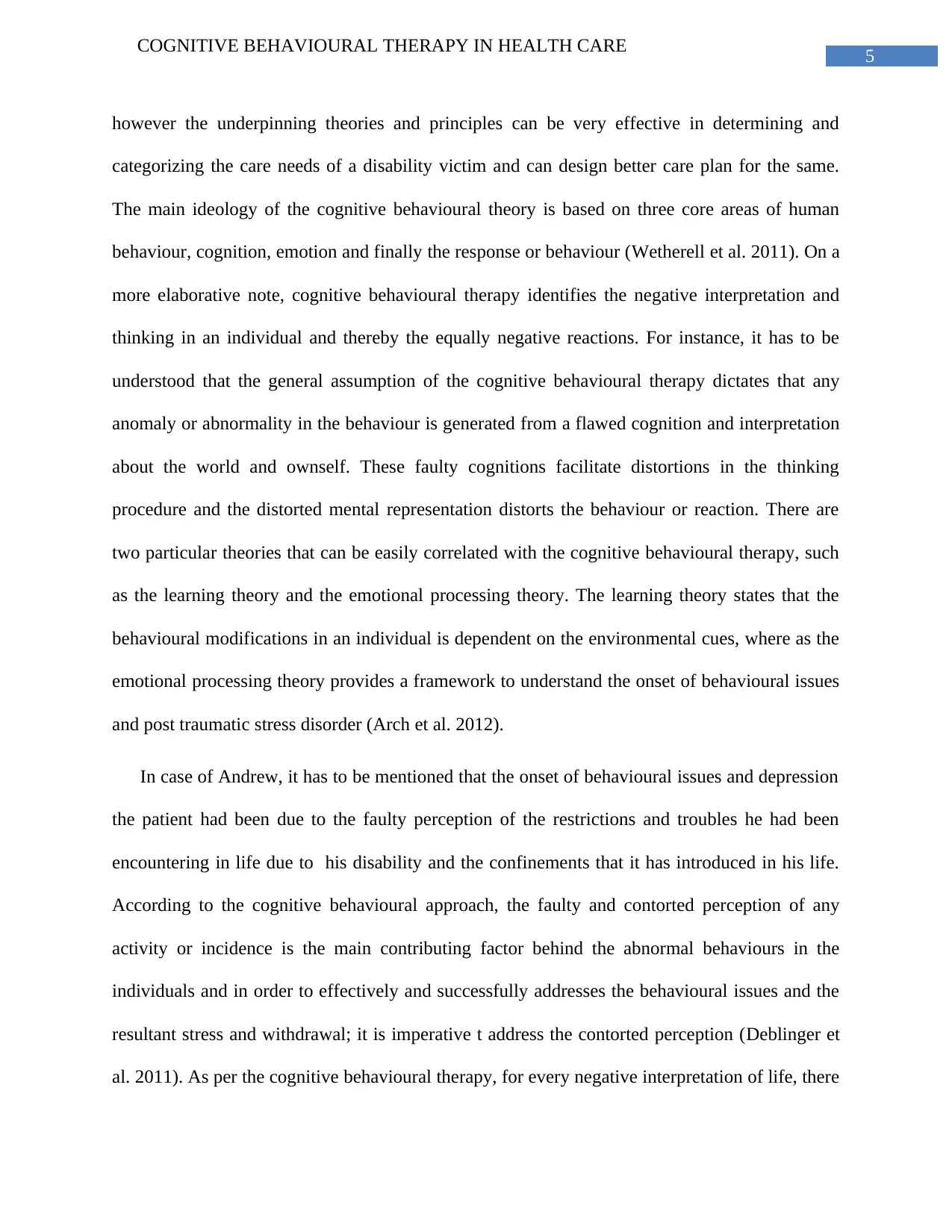
5
COGNITIVE BEHAVIOURAL THERAPY IN HEALTH CARE
however the underpinning theories and principles can be very effective in determining and
categorizing the care needs of a disability victim and can design better care plan for the same.
The main ideology of the cognitive behavioural theory is based on three core areas of human
behaviour, cognition, emotion and finally the response or behaviour (Wetherell et al. 2011). On a
more elaborative note, cognitive behavioural therapy identifies the negative interpretation and
thinking in an individual and thereby the equally negative reactions. For instance, it has to be
understood that the general assumption of the cognitive behavioural therapy dictates that any
anomaly or abnormality in the behaviour is generated from a flawed cognition and interpretation
about the world and ownself. These faulty cognitions facilitate distortions in the thinking
procedure and the distorted mental representation distorts the behaviour or reaction. There are
two particular theories that can be easily correlated with the cognitive behavioural therapy, such
as the learning theory and the emotional processing theory. The learning theory states that the
behavioural modifications in an individual is dependent on the environmental cues, where as the
emotional processing theory provides a framework to understand the onset of behavioural issues
and post traumatic stress disorder (Arch et al. 2012).
In case of Andrew, it has to be mentioned that the onset of behavioural issues and depression
the patient had been due to the faulty perception of the restrictions and troubles he had been
encountering in life due to his disability and the confinements that it has introduced in his life.
According to the cognitive behavioural approach, the faulty and contorted perception of any
activity or incidence is the main contributing factor behind the abnormal behaviours in the
individuals and in order to effectively and successfully addresses the behavioural issues and the
resultant stress and withdrawal; it is imperative t address the contorted perception (Deblinger et
al. 2011). As per the cognitive behavioural therapy, for every negative interpretation of life, there
COGNITIVE BEHAVIOURAL THERAPY IN HEALTH CARE
however the underpinning theories and principles can be very effective in determining and
categorizing the care needs of a disability victim and can design better care plan for the same.
The main ideology of the cognitive behavioural theory is based on three core areas of human
behaviour, cognition, emotion and finally the response or behaviour (Wetherell et al. 2011). On a
more elaborative note, cognitive behavioural therapy identifies the negative interpretation and
thinking in an individual and thereby the equally negative reactions. For instance, it has to be
understood that the general assumption of the cognitive behavioural therapy dictates that any
anomaly or abnormality in the behaviour is generated from a flawed cognition and interpretation
about the world and ownself. These faulty cognitions facilitate distortions in the thinking
procedure and the distorted mental representation distorts the behaviour or reaction. There are
two particular theories that can be easily correlated with the cognitive behavioural therapy, such
as the learning theory and the emotional processing theory. The learning theory states that the
behavioural modifications in an individual is dependent on the environmental cues, where as the
emotional processing theory provides a framework to understand the onset of behavioural issues
and post traumatic stress disorder (Arch et al. 2012).
In case of Andrew, it has to be mentioned that the onset of behavioural issues and depression
the patient had been due to the faulty perception of the restrictions and troubles he had been
encountering in life due to his disability and the confinements that it has introduced in his life.
According to the cognitive behavioural approach, the faulty and contorted perception of any
activity or incidence is the main contributing factor behind the abnormal behaviours in the
individuals and in order to effectively and successfully addresses the behavioural issues and the
resultant stress and withdrawal; it is imperative t address the contorted perception (Deblinger et
al. 2011). As per the cognitive behavioural therapy, for every negative interpretation of life, there
⊘ This is a preview!⊘
Do you want full access?
Subscribe today to unlock all pages.

Trusted by 1+ million students worldwide
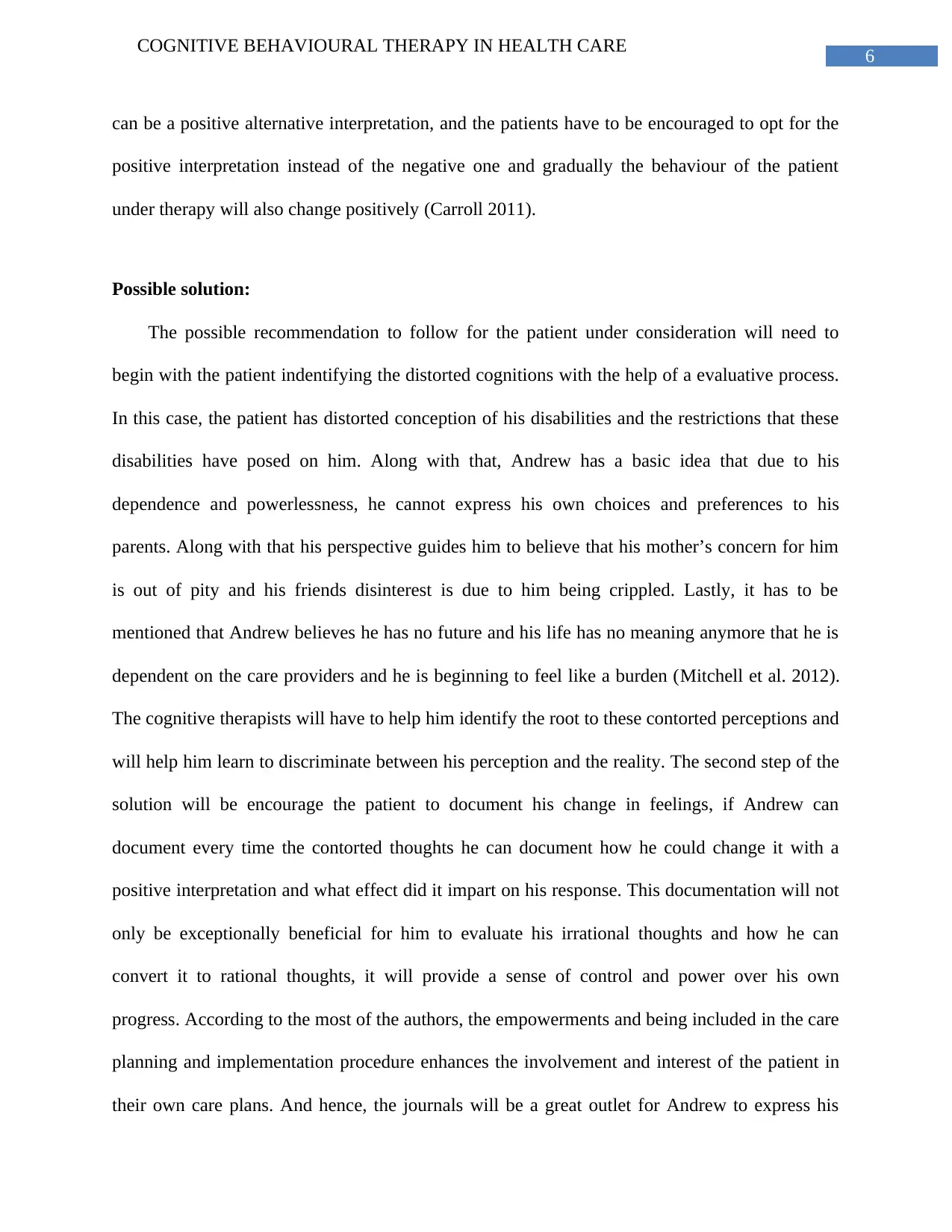
6
COGNITIVE BEHAVIOURAL THERAPY IN HEALTH CARE
can be a positive alternative interpretation, and the patients have to be encouraged to opt for the
positive interpretation instead of the negative one and gradually the behaviour of the patient
under therapy will also change positively (Carroll 2011).
Possible solution:
The possible recommendation to follow for the patient under consideration will need to
begin with the patient indentifying the distorted cognitions with the help of a evaluative process.
In this case, the patient has distorted conception of his disabilities and the restrictions that these
disabilities have posed on him. Along with that, Andrew has a basic idea that due to his
dependence and powerlessness, he cannot express his own choices and preferences to his
parents. Along with that his perspective guides him to believe that his mother’s concern for him
is out of pity and his friends disinterest is due to him being crippled. Lastly, it has to be
mentioned that Andrew believes he has no future and his life has no meaning anymore that he is
dependent on the care providers and he is beginning to feel like a burden (Mitchell et al. 2012).
The cognitive therapists will have to help him identify the root to these contorted perceptions and
will help him learn to discriminate between his perception and the reality. The second step of the
solution will be encourage the patient to document his change in feelings, if Andrew can
document every time the contorted thoughts he can document how he could change it with a
positive interpretation and what effect did it impart on his response. This documentation will not
only be exceptionally beneficial for him to evaluate his irrational thoughts and how he can
convert it to rational thoughts, it will provide a sense of control and power over his own
progress. According to the most of the authors, the empowerments and being included in the care
planning and implementation procedure enhances the involvement and interest of the patient in
their own care plans. And hence, the journals will be a great outlet for Andrew to express his
COGNITIVE BEHAVIOURAL THERAPY IN HEALTH CARE
can be a positive alternative interpretation, and the patients have to be encouraged to opt for the
positive interpretation instead of the negative one and gradually the behaviour of the patient
under therapy will also change positively (Carroll 2011).
Possible solution:
The possible recommendation to follow for the patient under consideration will need to
begin with the patient indentifying the distorted cognitions with the help of a evaluative process.
In this case, the patient has distorted conception of his disabilities and the restrictions that these
disabilities have posed on him. Along with that, Andrew has a basic idea that due to his
dependence and powerlessness, he cannot express his own choices and preferences to his
parents. Along with that his perspective guides him to believe that his mother’s concern for him
is out of pity and his friends disinterest is due to him being crippled. Lastly, it has to be
mentioned that Andrew believes he has no future and his life has no meaning anymore that he is
dependent on the care providers and he is beginning to feel like a burden (Mitchell et al. 2012).
The cognitive therapists will have to help him identify the root to these contorted perceptions and
will help him learn to discriminate between his perception and the reality. The second step of the
solution will be encourage the patient to document his change in feelings, if Andrew can
document every time the contorted thoughts he can document how he could change it with a
positive interpretation and what effect did it impart on his response. This documentation will not
only be exceptionally beneficial for him to evaluate his irrational thoughts and how he can
convert it to rational thoughts, it will provide a sense of control and power over his own
progress. According to the most of the authors, the empowerments and being included in the care
planning and implementation procedure enhances the involvement and interest of the patient in
their own care plans. And hence, the journals will be a great outlet for Andrew to express his
Paraphrase This Document
Need a fresh take? Get an instant paraphrase of this document with our AI Paraphraser
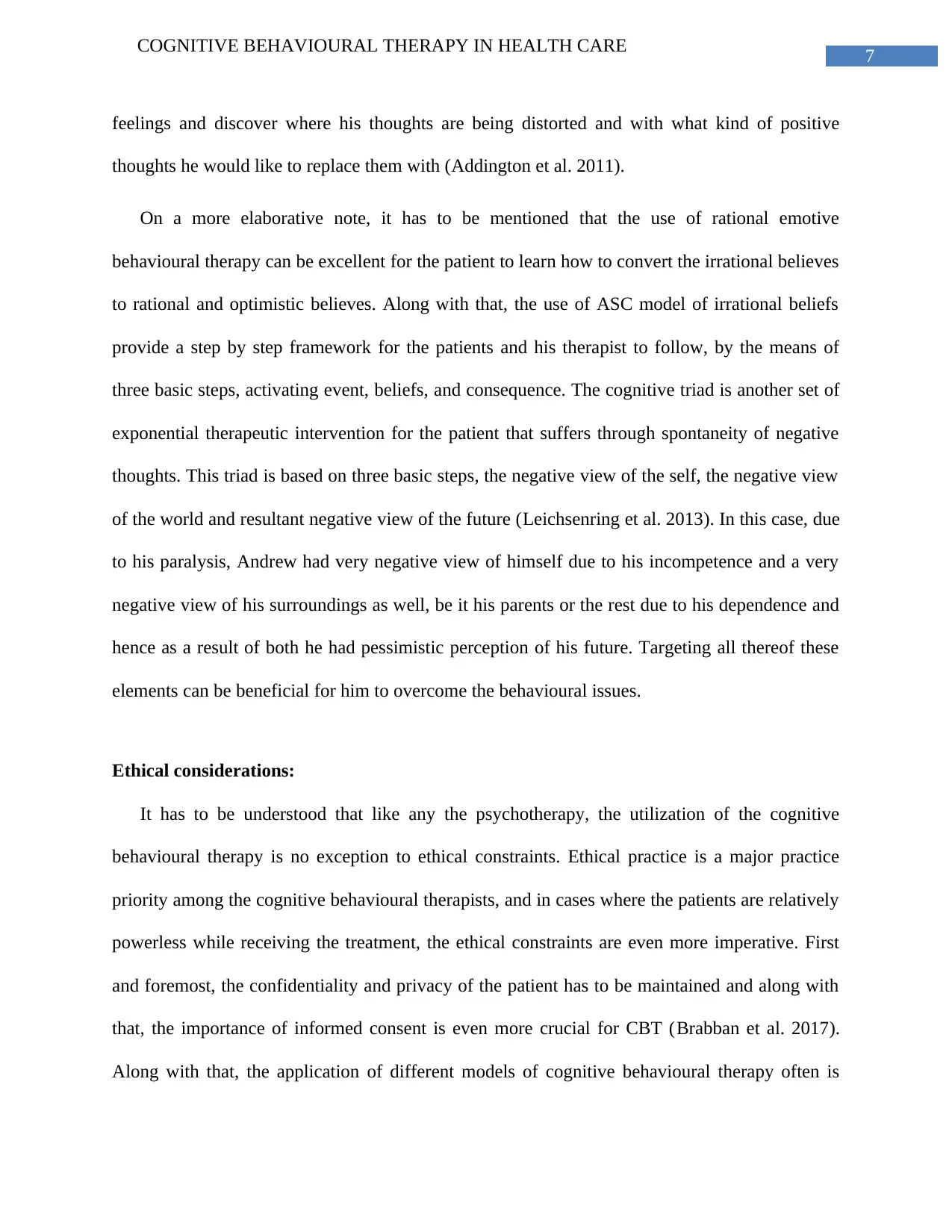
7
COGNITIVE BEHAVIOURAL THERAPY IN HEALTH CARE
feelings and discover where his thoughts are being distorted and with what kind of positive
thoughts he would like to replace them with (Addington et al. 2011).
On a more elaborative note, it has to be mentioned that the use of rational emotive
behavioural therapy can be excellent for the patient to learn how to convert the irrational believes
to rational and optimistic believes. Along with that, the use of ASC model of irrational beliefs
provide a step by step framework for the patients and his therapist to follow, by the means of
three basic steps, activating event, beliefs, and consequence. The cognitive triad is another set of
exponential therapeutic intervention for the patient that suffers through spontaneity of negative
thoughts. This triad is based on three basic steps, the negative view of the self, the negative view
of the world and resultant negative view of the future (Leichsenring et al. 2013). In this case, due
to his paralysis, Andrew had very negative view of himself due to his incompetence and a very
negative view of his surroundings as well, be it his parents or the rest due to his dependence and
hence as a result of both he had pessimistic perception of his future. Targeting all thereof these
elements can be beneficial for him to overcome the behavioural issues.
Ethical considerations:
It has to be understood that like any the psychotherapy, the utilization of the cognitive
behavioural therapy is no exception to ethical constraints. Ethical practice is a major practice
priority among the cognitive behavioural therapists, and in cases where the patients are relatively
powerless while receiving the treatment, the ethical constraints are even more imperative. First
and foremost, the confidentiality and privacy of the patient has to be maintained and along with
that, the importance of informed consent is even more crucial for CBT (Brabban et al. 2017).
Along with that, the application of different models of cognitive behavioural therapy often is
COGNITIVE BEHAVIOURAL THERAPY IN HEALTH CARE
feelings and discover where his thoughts are being distorted and with what kind of positive
thoughts he would like to replace them with (Addington et al. 2011).
On a more elaborative note, it has to be mentioned that the use of rational emotive
behavioural therapy can be excellent for the patient to learn how to convert the irrational believes
to rational and optimistic believes. Along with that, the use of ASC model of irrational beliefs
provide a step by step framework for the patients and his therapist to follow, by the means of
three basic steps, activating event, beliefs, and consequence. The cognitive triad is another set of
exponential therapeutic intervention for the patient that suffers through spontaneity of negative
thoughts. This triad is based on three basic steps, the negative view of the self, the negative view
of the world and resultant negative view of the future (Leichsenring et al. 2013). In this case, due
to his paralysis, Andrew had very negative view of himself due to his incompetence and a very
negative view of his surroundings as well, be it his parents or the rest due to his dependence and
hence as a result of both he had pessimistic perception of his future. Targeting all thereof these
elements can be beneficial for him to overcome the behavioural issues.
Ethical considerations:
It has to be understood that like any the psychotherapy, the utilization of the cognitive
behavioural therapy is no exception to ethical constraints. Ethical practice is a major practice
priority among the cognitive behavioural therapists, and in cases where the patients are relatively
powerless while receiving the treatment, the ethical constraints are even more imperative. First
and foremost, the confidentiality and privacy of the patient has to be maintained and along with
that, the importance of informed consent is even more crucial for CBT (Brabban et al. 2017).
Along with that, the application of different models of cognitive behavioural therapy often is
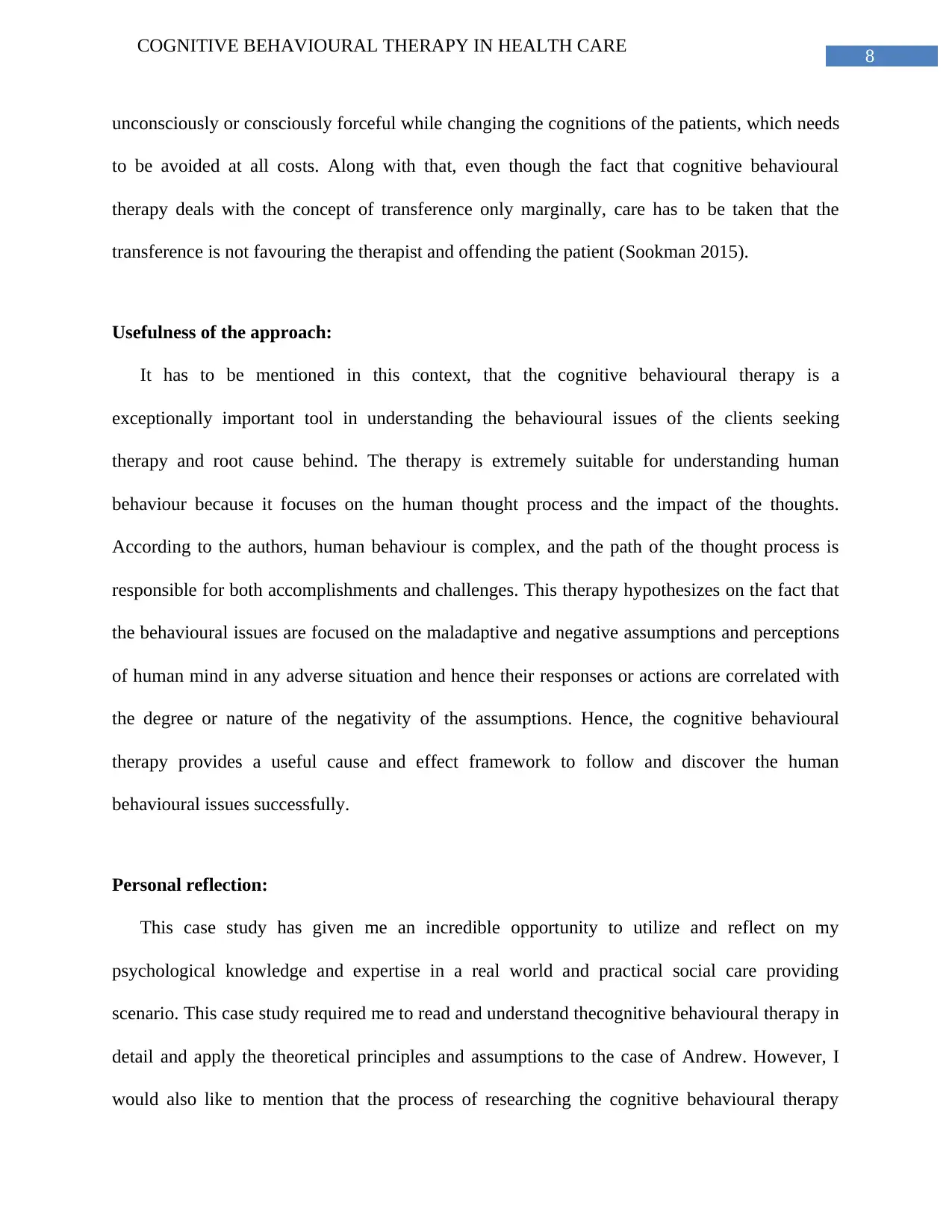
8
COGNITIVE BEHAVIOURAL THERAPY IN HEALTH CARE
unconsciously or consciously forceful while changing the cognitions of the patients, which needs
to be avoided at all costs. Along with that, even though the fact that cognitive behavioural
therapy deals with the concept of transference only marginally, care has to be taken that the
transference is not favouring the therapist and offending the patient (Sookman 2015).
Usefulness of the approach:
It has to be mentioned in this context, that the cognitive behavioural therapy is a
exceptionally important tool in understanding the behavioural issues of the clients seeking
therapy and root cause behind. The therapy is extremely suitable for understanding human
behaviour because it focuses on the human thought process and the impact of the thoughts.
According to the authors, human behaviour is complex, and the path of the thought process is
responsible for both accomplishments and challenges. This therapy hypothesizes on the fact that
the behavioural issues are focused on the maladaptive and negative assumptions and perceptions
of human mind in any adverse situation and hence their responses or actions are correlated with
the degree or nature of the negativity of the assumptions. Hence, the cognitive behavioural
therapy provides a useful cause and effect framework to follow and discover the human
behavioural issues successfully.
Personal reflection:
This case study has given me an incredible opportunity to utilize and reflect on my
psychological knowledge and expertise in a real world and practical social care providing
scenario. This case study required me to read and understand thecognitive behavioural therapy in
detail and apply the theoretical principles and assumptions to the case of Andrew. However, I
would also like to mention that the process of researching the cognitive behavioural therapy
COGNITIVE BEHAVIOURAL THERAPY IN HEALTH CARE
unconsciously or consciously forceful while changing the cognitions of the patients, which needs
to be avoided at all costs. Along with that, even though the fact that cognitive behavioural
therapy deals with the concept of transference only marginally, care has to be taken that the
transference is not favouring the therapist and offending the patient (Sookman 2015).
Usefulness of the approach:
It has to be mentioned in this context, that the cognitive behavioural therapy is a
exceptionally important tool in understanding the behavioural issues of the clients seeking
therapy and root cause behind. The therapy is extremely suitable for understanding human
behaviour because it focuses on the human thought process and the impact of the thoughts.
According to the authors, human behaviour is complex, and the path of the thought process is
responsible for both accomplishments and challenges. This therapy hypothesizes on the fact that
the behavioural issues are focused on the maladaptive and negative assumptions and perceptions
of human mind in any adverse situation and hence their responses or actions are correlated with
the degree or nature of the negativity of the assumptions. Hence, the cognitive behavioural
therapy provides a useful cause and effect framework to follow and discover the human
behavioural issues successfully.
Personal reflection:
This case study has given me an incredible opportunity to utilize and reflect on my
psychological knowledge and expertise in a real world and practical social care providing
scenario. This case study required me to read and understand thecognitive behavioural therapy in
detail and apply the theoretical principles and assumptions to the case of Andrew. However, I
would also like to mention that the process of researching the cognitive behavioural therapy
⊘ This is a preview!⊘
Do you want full access?
Subscribe today to unlock all pages.

Trusted by 1+ million students worldwide
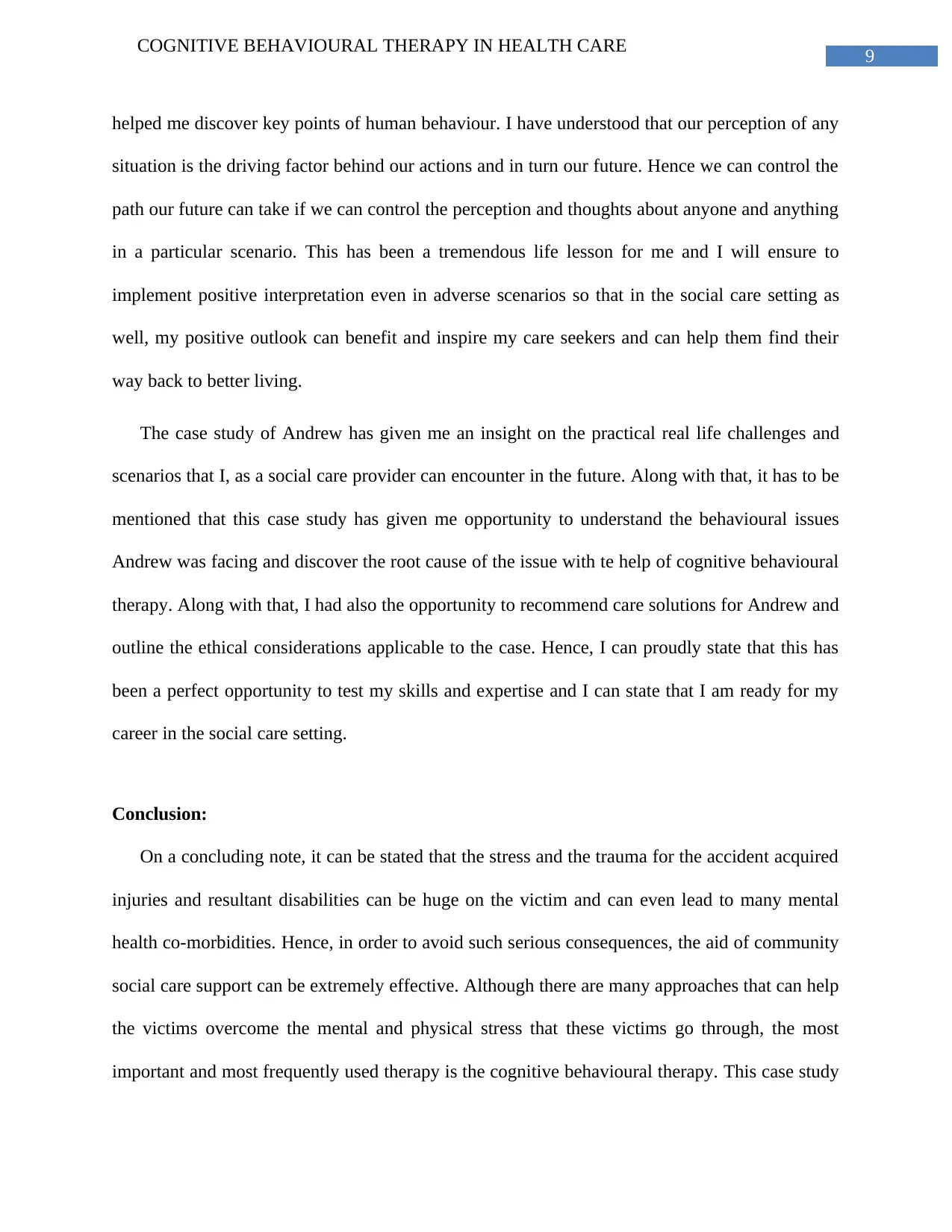
9
COGNITIVE BEHAVIOURAL THERAPY IN HEALTH CARE
helped me discover key points of human behaviour. I have understood that our perception of any
situation is the driving factor behind our actions and in turn our future. Hence we can control the
path our future can take if we can control the perception and thoughts about anyone and anything
in a particular scenario. This has been a tremendous life lesson for me and I will ensure to
implement positive interpretation even in adverse scenarios so that in the social care setting as
well, my positive outlook can benefit and inspire my care seekers and can help them find their
way back to better living.
The case study of Andrew has given me an insight on the practical real life challenges and
scenarios that I, as a social care provider can encounter in the future. Along with that, it has to be
mentioned that this case study has given me opportunity to understand the behavioural issues
Andrew was facing and discover the root cause of the issue with te help of cognitive behavioural
therapy. Along with that, I had also the opportunity to recommend care solutions for Andrew and
outline the ethical considerations applicable to the case. Hence, I can proudly state that this has
been a perfect opportunity to test my skills and expertise and I can state that I am ready for my
career in the social care setting.
Conclusion:
On a concluding note, it can be stated that the stress and the trauma for the accident acquired
injuries and resultant disabilities can be huge on the victim and can even lead to many mental
health co-morbidities. Hence, in order to avoid such serious consequences, the aid of community
social care support can be extremely effective. Although there are many approaches that can help
the victims overcome the mental and physical stress that these victims go through, the most
important and most frequently used therapy is the cognitive behavioural therapy. This case study
COGNITIVE BEHAVIOURAL THERAPY IN HEALTH CARE
helped me discover key points of human behaviour. I have understood that our perception of any
situation is the driving factor behind our actions and in turn our future. Hence we can control the
path our future can take if we can control the perception and thoughts about anyone and anything
in a particular scenario. This has been a tremendous life lesson for me and I will ensure to
implement positive interpretation even in adverse scenarios so that in the social care setting as
well, my positive outlook can benefit and inspire my care seekers and can help them find their
way back to better living.
The case study of Andrew has given me an insight on the practical real life challenges and
scenarios that I, as a social care provider can encounter in the future. Along with that, it has to be
mentioned that this case study has given me opportunity to understand the behavioural issues
Andrew was facing and discover the root cause of the issue with te help of cognitive behavioural
therapy. Along with that, I had also the opportunity to recommend care solutions for Andrew and
outline the ethical considerations applicable to the case. Hence, I can proudly state that this has
been a perfect opportunity to test my skills and expertise and I can state that I am ready for my
career in the social care setting.
Conclusion:
On a concluding note, it can be stated that the stress and the trauma for the accident acquired
injuries and resultant disabilities can be huge on the victim and can even lead to many mental
health co-morbidities. Hence, in order to avoid such serious consequences, the aid of community
social care support can be extremely effective. Although there are many approaches that can help
the victims overcome the mental and physical stress that these victims go through, the most
important and most frequently used therapy is the cognitive behavioural therapy. This case study
Paraphrase This Document
Need a fresh take? Get an instant paraphrase of this document with our AI Paraphraser
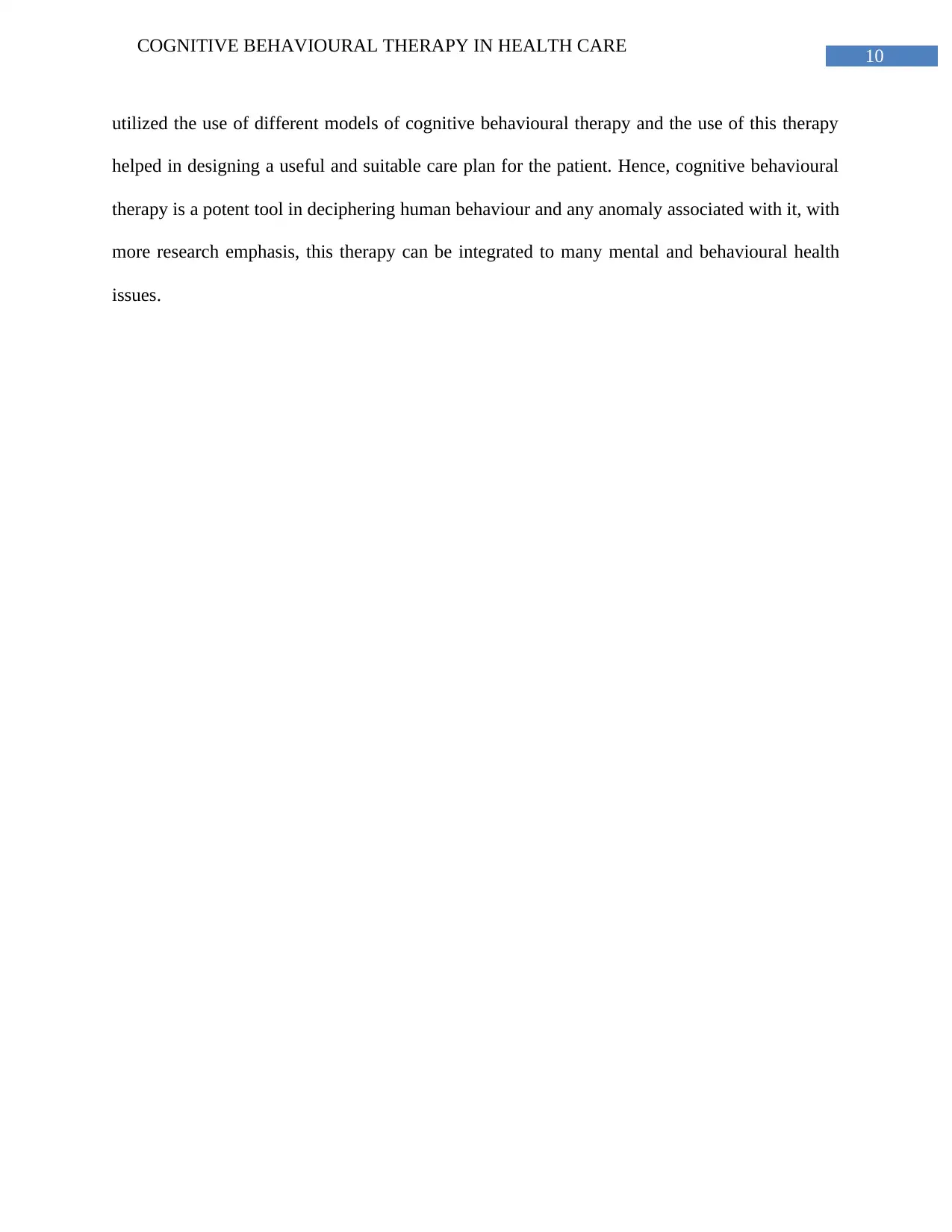
10
COGNITIVE BEHAVIOURAL THERAPY IN HEALTH CARE
utilized the use of different models of cognitive behavioural therapy and the use of this therapy
helped in designing a useful and suitable care plan for the patient. Hence, cognitive behavioural
therapy is a potent tool in deciphering human behaviour and any anomaly associated with it, with
more research emphasis, this therapy can be integrated to many mental and behavioural health
issues.
COGNITIVE BEHAVIOURAL THERAPY IN HEALTH CARE
utilized the use of different models of cognitive behavioural therapy and the use of this therapy
helped in designing a useful and suitable care plan for the patient. Hence, cognitive behavioural
therapy is a potent tool in deciphering human behaviour and any anomaly associated with it, with
more research emphasis, this therapy can be integrated to many mental and behavioural health
issues.
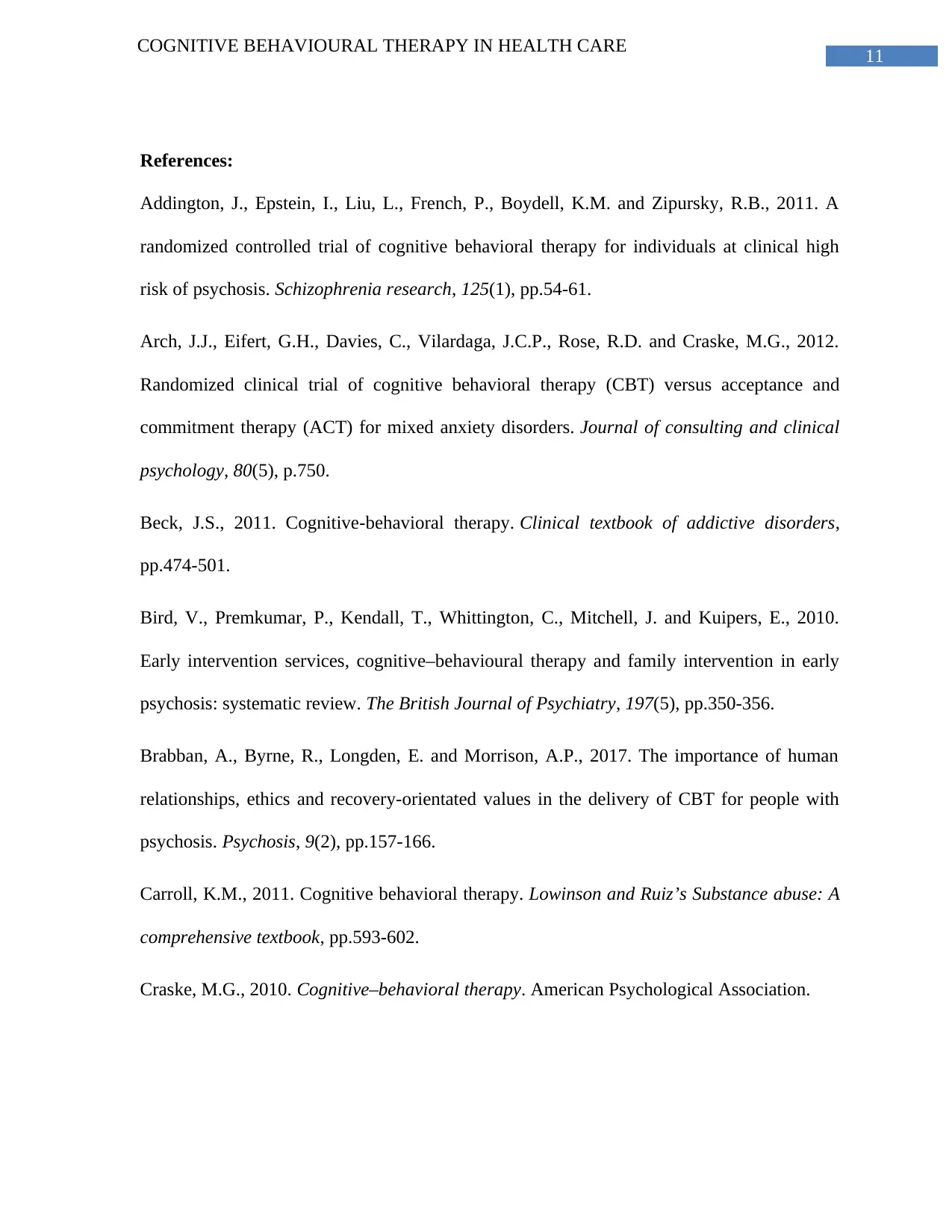
11
COGNITIVE BEHAVIOURAL THERAPY IN HEALTH CARE
References:
Addington, J., Epstein, I., Liu, L., French, P., Boydell, K.M. and Zipursky, R.B., 2011. A
randomized controlled trial of cognitive behavioral therapy for individuals at clinical high
risk of psychosis. Schizophrenia research, 125(1), pp.54-61.
Arch, J.J., Eifert, G.H., Davies, C., Vilardaga, J.C.P., Rose, R.D. and Craske, M.G., 2012.
Randomized clinical trial of cognitive behavioral therapy (CBT) versus acceptance and
commitment therapy (ACT) for mixed anxiety disorders. Journal of consulting and clinical
psychology, 80(5), p.750.
Beck, J.S., 2011. Cognitive-behavioral therapy. Clinical textbook of addictive disorders,
pp.474-501.
Bird, V., Premkumar, P., Kendall, T., Whittington, C., Mitchell, J. and Kuipers, E., 2010.
Early intervention services, cognitive–behavioural therapy and family intervention in early
psychosis: systematic review. The British Journal of Psychiatry, 197(5), pp.350-356.
Brabban, A., Byrne, R., Longden, E. and Morrison, A.P., 2017. The importance of human
relationships, ethics and recovery-orientated values in the delivery of CBT for people with
psychosis. Psychosis, 9(2), pp.157-166.
Carroll, K.M., 2011. Cognitive behavioral therapy. Lowinson and Ruiz’s Substance abuse: A
comprehensive textbook, pp.593-602.
Craske, M.G., 2010. Cognitive–behavioral therapy. American Psychological Association.
COGNITIVE BEHAVIOURAL THERAPY IN HEALTH CARE
References:
Addington, J., Epstein, I., Liu, L., French, P., Boydell, K.M. and Zipursky, R.B., 2011. A
randomized controlled trial of cognitive behavioral therapy for individuals at clinical high
risk of psychosis. Schizophrenia research, 125(1), pp.54-61.
Arch, J.J., Eifert, G.H., Davies, C., Vilardaga, J.C.P., Rose, R.D. and Craske, M.G., 2012.
Randomized clinical trial of cognitive behavioral therapy (CBT) versus acceptance and
commitment therapy (ACT) for mixed anxiety disorders. Journal of consulting and clinical
psychology, 80(5), p.750.
Beck, J.S., 2011. Cognitive-behavioral therapy. Clinical textbook of addictive disorders,
pp.474-501.
Bird, V., Premkumar, P., Kendall, T., Whittington, C., Mitchell, J. and Kuipers, E., 2010.
Early intervention services, cognitive–behavioural therapy and family intervention in early
psychosis: systematic review. The British Journal of Psychiatry, 197(5), pp.350-356.
Brabban, A., Byrne, R., Longden, E. and Morrison, A.P., 2017. The importance of human
relationships, ethics and recovery-orientated values in the delivery of CBT for people with
psychosis. Psychosis, 9(2), pp.157-166.
Carroll, K.M., 2011. Cognitive behavioral therapy. Lowinson and Ruiz’s Substance abuse: A
comprehensive textbook, pp.593-602.
Craske, M.G., 2010. Cognitive–behavioral therapy. American Psychological Association.
⊘ This is a preview!⊘
Do you want full access?
Subscribe today to unlock all pages.

Trusted by 1+ million students worldwide
1 out of 14
Related Documents
Your All-in-One AI-Powered Toolkit for Academic Success.
+13062052269
info@desklib.com
Available 24*7 on WhatsApp / Email
![[object Object]](/_next/static/media/star-bottom.7253800d.svg)
Unlock your academic potential
Copyright © 2020–2025 A2Z Services. All Rights Reserved. Developed and managed by ZUCOL.




